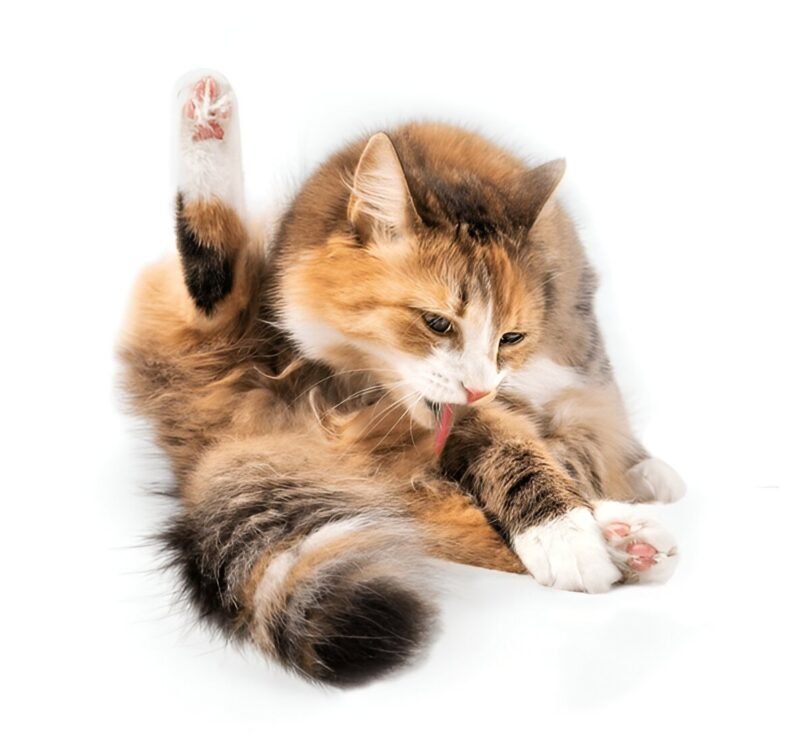Introduction
Have you noticed your cat licking, biting, or grooming itself excessively? While grooming is a normal behavior in cats, overgrooming can indicate an underlying issue. It can lead to fur loss, skin irritation, and discomfort if not addressed.
In this article, we’ll explore why cats overgroom, common causes, and effective ways to stop it so your furry friend stays happy and healthy.
What is Overgrooming in Cats?
Overgrooming occurs when a cat excessively licks, bites, or pulls at its fur, leading to bald spots, skin irritation, and even open sores. It’s also known as psychogenic alopecia when linked to stress or anxiety.
Signs Your Cat is Overgrooming:
✔ Constant licking, especially in one area
✔ Bald patches or thinning fur
✔ Red or irritated skin
✔ Hairballs from excessive fur ingestion
✔ Restlessness or anxiety behaviors
If you notice these signs, it’s important to find the root cause and take action.
Why is My Cat Overgrooming?
1. Allergies (Food or Environmental)
Cats can develop allergic reactions to certain foods, pollen, dust, or flea bites, causing itchy skin and excessive grooming.
🔍 Signs of Allergies:
- Frequent scratching
- Red, inflamed skin
- Ear infections or watery eyes
🩺 Solution:
✔ Switch to hypoallergenic cat food
✔ Keep your home clean and dust-free
✔ Use flea prevention treatments
2. Stress and Anxiety
Cats often groom as a self-soothing mechanism, similar to how humans bite their nails. Changes in routine, loud noises, or new pets can cause stress-related overgrooming.
🔍 Common Stress Triggers:
- Moving to a new home
- Changes in household members (new baby, pet, or visitor)
- Lack of stimulation or boredom
🩺 Solution:
✔ Provide hiding spots and a safe space
✔ Use calming diffusers (Feliway)
✔ Increase playtime and enrichment
3. Skin Parasites (Fleas, Mites, or Ticks)
Fleas and mites can make your cat’s skin itchy and uncomfortable, leading to excessive licking. Even indoor cats can get fleas!
🔍 Signs of Parasites:
- Constant scratching
- Tiny black specks (flea dirt)
- Red, irritated skin
🩺 Solution:
✔ Use vet-approved flea treatments
✔ Regularly wash bedding and vacuum carpets
✔ Check your cat’s fur using a flea comb
4. Pain or Underlying Health Issues
Sometimes, overgrooming is a sign of pain due to arthritis, urinary tract infections (UTIs), or skin conditions. Cats may lick one area excessively to soothe discomfort.
🔍 Pain-Related Grooming Signs:
- Overgrooming a specific spot (e.g., belly, joints)
- Changes in walking or jumping
- Loss of appetite or lethargy
🩺 Solution:
✔ Schedule a vet check-up
✔ Manage pain with prescribed medications
✔ Provide soft bedding for comfort
5. Boredom and Lack of Stimulation
Cats need mental and physical stimulation, and some may overgroom due to boredom.
🔍 Signs of Boredom:
- Excessive grooming when alone
- Destructive behavior (scratching furniture)
- Sleeping too much
🩺 Solution:
✔ Introduce interactive toys and puzzle feeders
✔ Provide a scratching post and climbing tree
✔ Engage in daily play sessions
How to Stop Your Cat from Overgrooming
🐾 1. Identify and Address the Root Cause
- Check for allergies, parasites, or health issues
- Observe if stress or environmental changes are causing anxiety
🐾 2. Create a Stress-Free Environment
- Use calming sprays or pheromone diffusers
- Keep feeding and playtime routines consistent
🐾 3. Provide Enrichment and Distractions
- Interactive play sessions (chasing, puzzle toys)
- Add cat trees, tunnels, and scratching posts
🐾 4. Use an Anti-Lick Collar or Soft Recovery Suit
- If the grooming is causing harm, a vet may recommend a cone or recovery suit to prevent further irritation.
🐾 5. Consult a Veterinarian
- If the overgrooming persists, a vet can diagnose medical conditions or prescribe medication for anxiety-related grooming.
Final Thoughts
Overgrooming in cats can be caused by allergies, stress, parasites, boredom, or underlying health conditions. Identifying the root cause and making simple changes can help your cat regain healthy fur and feel comfortable again.
🐱 Has your cat experienced overgrooming? Share your experience and solutions in the comments!







